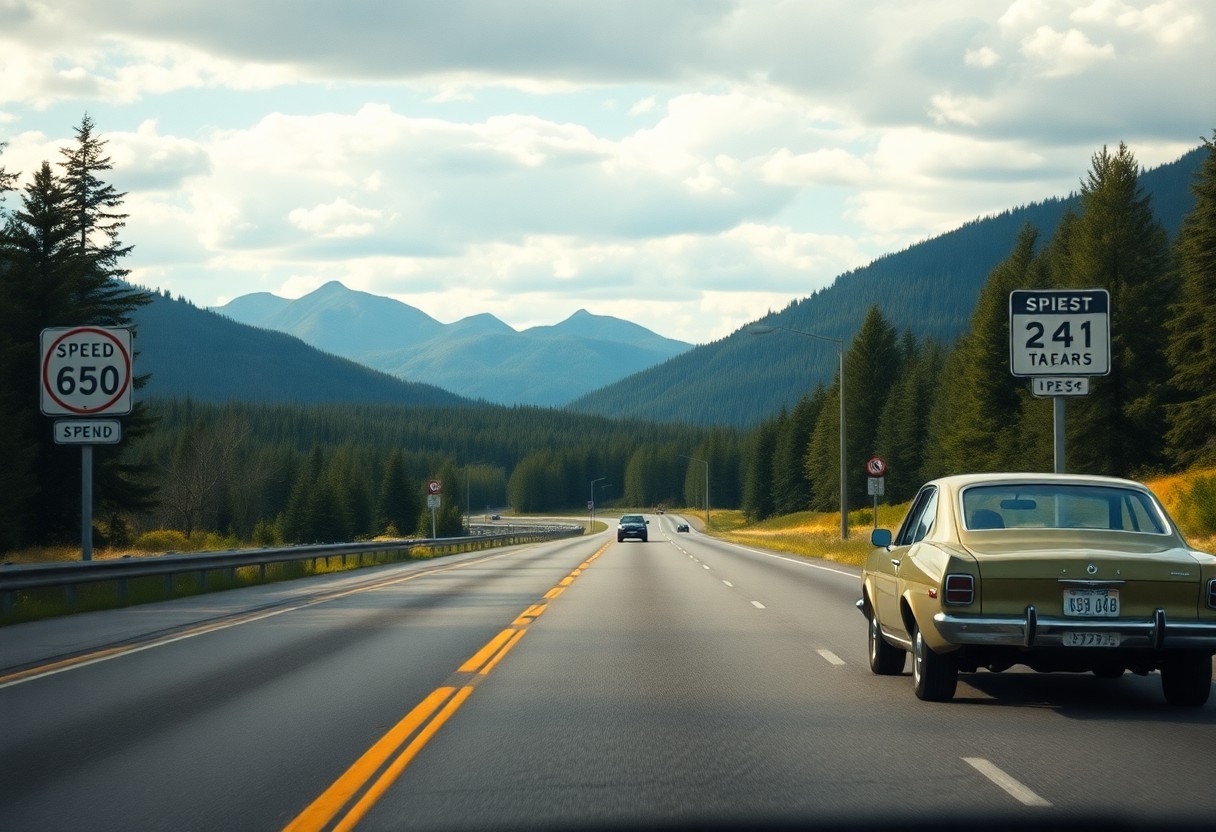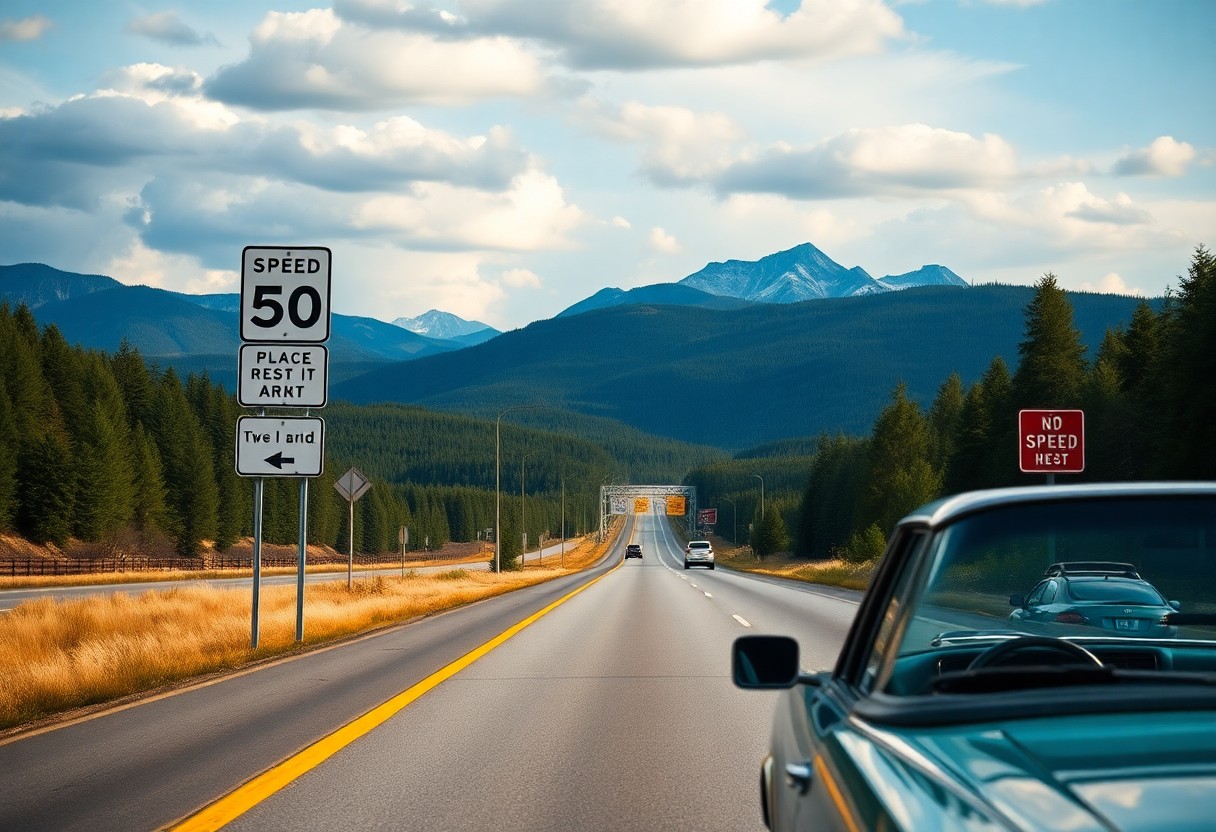When planning a trip to the US, you need to know the imperative rules and regulations for driving. Your safety is strongly dependent on understanding the specifics of driving in the US. To ensure a smooth and enjoyable road trip, you should research the requirements for driving in the US, including the minimum age and necessary documents, such as a full and valid UK driving licence, valid passport, proof of insurance, and warning triangles. You should also consider renting a car and familiarize yourself with the rules on the road, including speed limits, stop signs, and road types, to make the most of your US road trip experience. Additionally, you can rent a car to explore the country’s scenic routes and vibrant cities.
Types of Roads and Driving Requirements
While driving in the US, you’ll encounter various types of roads, including Interstate highways, state highways, and county highways. You should be aware of the following:
- Driver’s license: required for driving
- Insurance: mandatory in most states
- Seat belts: mandatory in all states
- Speed limits: vary by state and road type
- Tolls: may be required on certain highways and bridges
Thou should always check the specific requirements for each state and road type before driving.
| Road Type | Description |
|---|---|
| Interstate highways | High-speed roads for long-distance travel |
| State highways | Roads managed by individual states |
| County highways | Smaller roads managed by counties |
| City streets | Local roads with varying speed limits |
| Rural roads | Winding roads with lower speed limits |
Types of roads in the US
To get familiar with the road network in the US, you should know that there are various types of roads, including highways, freeways, and city streets. You can expect to find:
- Interstate highways: connect major cities
- State highways: connect smaller towns and cities
- County highways: local roads with varying conditions
- Rural roads: scenic routes with lower speed limits
- City streets: busy roads with traffic lights and pedestrians
Any driver should be aware of the different road types and their characteristics to ensure a safe and enjoyable journey.
| Road Type | Speed Limit |
|---|---|
| Interstate highways | Up to 80mph |
| State highways | Up to 65mph |
| County highways | Up to 45mph |
| Rural roads | Up to 30mph |
| City streets | Up to 25mph |
Requirements for driving in the US
Types of documents you need to drive in the US include a valid driver’s license, proof of insurance, and a valid passport. You should also be aware of the specific requirements for car rental companies, such as the minimum age and insurance requirements.
The requirements for driving in the US vary by state, but you can generally expect to need a valid driver’s license, proof of insurance, and a valid passport. You should also be aware of the specific requirements of car companies, such as the minimum age and insurance requirements. Car rental companies may have additional requirements, such as a credit card or debit card, and you should always check the terms and conditions before renting a car. Additionally, you should be aware of the rules of the road, including speed limits, traffic signs, and right-of-way rules, to ensure a safe and enjoyable journey. Rent a car companies offer a variety of vehicles, including economy, compact, and SUVs, so you can choose the one that best fits your needs.

Step-by-Step Guide to Hiring a Car
Even when hiring a car in the US, you’ll need to know the vital rules and requirements. The following table breaks down the key information:
| Requirement | Description |
|---|---|
| Age | Most car hire companies do not hire to drivers under 21 |
| Licence | Full UK driving licence, held for at least a year |
| ID | Valid passport |
| Payment | Credit card, or debit card with some agencies |
| Insurance | Liability insurance, and optional Collision Damage Waiver or Loss Damage Waiver |
Documentation and insurance required
Guided by the car hire agency’s requirements, you’ll need to provide your full UK driving licence, valid passport, and proof of insurance to hire a car in the US. Liability insurance is mandatory in most states, so ensure it’s included in your hire agreement.
Tips for hiring a car in the US
You should consider the following tips when hiring a car in the US:
- One-way car hire may be suitable for long road trips
- Debit cards may not be accepted by all agencies
- Insurance coverage should be checked to avoid duplicate payments
Thou should always read the hire contract carefully to understand what’s included and what’s not.
Tips for hiring a car in the US include opting for one-way car hire for long trips, and being aware that some agencies may not accept debit cards. Thou should also check the insurance coverage to avoid paying twice for the same protection, and consider purchasing a Collision Damage Waiver or Loss Damage Waiver for added peace of mind. Additionally, credit cards are often required for the deposit, and valid passports are necessary as proof of ID. Thou should always read the hire contract carefully to understand what’s included and what’s not, and look out for any additional fees or restrictions on your rental agreement.
Rules on the Road
One of the most important things to know when driving in the US is the rules on the road.
Right-hand driving and road types
You will be driving on the right-hand side of the road. The main road types are:
- Interstate highways
- State highways
- County highways
After researching the road types, you can plan your trip.
| Road Type | Description |
|---|---|
| Interstate highways | Used for freight transportation, long-distance travel, and regular commutes |
| State highways | Managed on a state level, varying in size |
| County highways | Managed on a county level, also called country roads |
| Urban roads | Lower speed limits, typically 30mph |
| Rural roads | Speed limits vary, typically up to 45mph |
Stop signs, speed limits, and priority rules
Rules dictate that you must come to a complete stop at a stop sign and give priority to traffic on the main road. Speed limits vary by state, and you should always follow the posted limits. When approaching an intersection without traffic lights, right of way is usually given to the car that arrived first.
Priority is given to the car that arrived first at an intersection without traffic lights. If two cars arrive at the same time, the one on the right has right of way. When overtaking, you must always overtake on the left. If you are on a two-lane road and a school bus stops, traffic on both sides of the road must stop until the bus leaves. The alcohol allowance for driving in the US is 0.08% for drivers over 21 years old.
Factors to Consider While Driving
Unlike other countries, the US has varying driving rules and regulations. You should consider the following:
- Road types
- Speed limits
- Toll roads
Thou should always follow these rules to ensure a safe and enjoyable trip.
Motorways and road tolls
You will encounter various road types in the US, including interstate highways and state highways. Some states have toll roads, while others do not.
Safety regulations and seat belts
Tolls are not the only thing you need to consider, safety regulations are also important. You must wear a seat belt while driving, and child seats are required for children under a certain age.
Another important aspect of safety regulations is the use of seat belts and child seats. You should always wear a seat belt while driving, and ensure that all passengers are properly restrained. Child seats are required for children under the age of two, and booster seats are required for children who have outgrown child seats. It is mandatory to follow these safety regulations to avoid penalties and ensure a safe trip. If you rent a car, make sure it has the necessary safety features, such as airbags and anti-lock brakes. You can rent a car that meets your safety needs and enjoy a safe and enjoyable trip.

Tips for a Smooth Drive
For a comfortable and safe trip, consider the following:
- Choose a car rental that suits your needs
- Plan your route in advance to avoid traffic
- Take regular breaks to rest and refuel
Assume that you have all the necessary documents, including a valid driver’s license and insurance, to avoid any issues during your trip.
How to handle intersections and overtaking
While driving in the US, you will encounter various types of intersections and overtaking situations. When approaching an intersection without traffic lights, right of way is usually given to the car that arrived first. If two cars arrive at the same time, the one on the right has right of way. When overtaking, always pass on the left and use your turn signals to indicate your intentions.
Parking and fuel options
Any driver in the US should be aware of the various parking options and fuel types available. When looking for a parking space, check for street signs indicating timing or payment restrictions. For fuel, you can choose from regular, mid-grade, or premium petrol, as well as diesel.
Fuel types in the US include Octane 87, Octane 89-90, and Octane 91-94, as well as diesel. You can pay for fuel with cash or card, and in most cases, you will need to prepay at the cashier before filling your rented car. Additionally, be aware of the parking regulations in different cities, such as color-coded parking spots and disabled parking spaces, to avoid any fines or penalties. When renting a car, make sure to choose a vehicle that suits your needs and budget, and always follow the traffic rules and regulations to ensure a smooth and safe drive.

Pros and Cons of Driving in the US
Now, you should consider the pros and cons of driving in the US.
| Pros | Cons |
|---|---|
| Scenic routes | High speed limits |
| Vast road network | Traffic congestion |
| Affordable car rental | Parking challenges |
| Flexible travel schedule | Steep fines for traffic offenses |
Benefits of driving in the US
One of the main advantages of driving in the US is the freedom to create your own itinerary and travel at your own pace, allowing you to enjoy the scenic routes and vast road network. With an affordable car rental, you can explore the country without breaking the bank.
Challenges and fines to be aware of
For a smooth driving experience in the US, you should be aware of the high speed limits and traffic congestion in certain areas. Additionally, parking challenges and steep fines for traffic offenses can be a concern, so it’s vital to research and understand the local traffic rules and regulations.
Pros of driving in the US include the flexible travel schedule and the opportunity to see breathtaking landscapes. However, you should also be aware of the challenges and fines associated with driving in the US, such as speeding tickets and parking fines. By understanding the pros and cons, you can make an informed decision about renting a car and exploring the country on your own terms. Car rental companies offer a wide range of vehicles, so you can choose the one that suits your needs and budget.
To wrap up
Summing up, you now have a better understanding of the important rules and tips for driving in the US. You know what to expect when renting a car, the rules of the road, and important safety measures. With this knowledge, you can confidently rent a car and enjoy your road trip in the US, exploring the country’s scenic routes and beautiful landscapes.
FAQ
What are the requirements for driving in the US as a visitor with a UK driving license?
Visitors with a UK driving license do not need an International Driving Permit (IDP) for up to three months. They must carry their full and valid UK driving license, a valid passport as proof of ID, proof of insurance, and warning triangles. The minimum age for driving varies by state, but most car hire companies require drivers to be at least 21 years old.
What do I need to hire a car in the US, and what are some tips to consider?
To hire a car in the US, you typically need a full UK driving license, a valid passport, a credit card for the deposit, and insurance. Tips include researching agency requirements, considering one-way car hire for long road trips, and understanding the insurance coverage included in the hire agreement. Additionally, be aware that some car hire companies may not accept certain payment methods, such as prepaid cards or cash.
What are the necessary rules to follow when driving in the US, such as which side of the road to drive on and speed limits?
In the US, cars drive on the right side of the road. Speed limits vary by state, with interstate highways typically having limits up to 80mph, four-lane roads up to 65mph, and urban areas usually having the lowest limit of 30mph. It’s also important to follow rules for stop signs, overtaking, and right of way, as well as to be aware of road types such as interstate highways, state highways, and county highways. Always wear a seat belt, as it is mandatory in most states, and be aware of the laws regarding alcohol consumption and driving, which vary by state but generally have a limit of 0.08% for drivers over 21 years old.




I really appreciate your focus on the rules and regulations surrounding driving in the US! Having traveled across the country myself, I found that understanding the road types and state-specific laws can genuinely enhance the experience.
This post gives such a clear overview of driving in the US, which is invaluable for anyone planning a trip! As someone who has taken several road trips across different states, I can’t emphasize enough how important it is to really understand the unique driving culture here.
It’s great to hear that you’ve had the chance to explore different states on road trips. Each state feels like its own little world, doesn’t it? The unique driving culture is something that can sometimes catch newcomers off guard. For instance, you might find that while some states embrace a more laid-back approach to speed limits and merging, others are more rigid about following the rules of the road.
Your insights into the rules and regulations for driving in the US are quite essential for anyone planning a road trip. However, I can’t help but think we often overlook the broader implications of understanding these driving norms beyond just safety and regulation compliance. It’s not simply about adhering to laws; it’s about immersing oneself in the diverse cultural landscapes that the US offers through its roadways.
It’s interesting to see how much goes into driving in the US, especially for those of us used to different rules back home! When I traveled there last summer, I was surprised by the variety of road types and how they really dictate the driving experience. For example, the serene drives along the Pacific Coast Highway felt worlds apart from the bustling highways of New York.
This is such a crucial aspect of planning a road trip in the US—understanding the driving regulations can truly make or break your experience. It reminds me of my first trip across America, where I underestimated the vast differences in driving laws from state to state. For instance, I was caught off guard by the varying speed limits, especially in rural areas where limits can be surprisingly low.
It’s fascinating how much preparation goes into driving in a different country, especially in a vast and diverse place like the US. Your emphasis on understanding local regulations is so crucial, as the rules can vary significantly from one state to another. For instance, did you know that while most states require you to be at least 16 or 18 to drive, there are some that allow certain licenses to be issued earlier with restrictions? It really highlights the importance of doing thorough research before hitting the road.